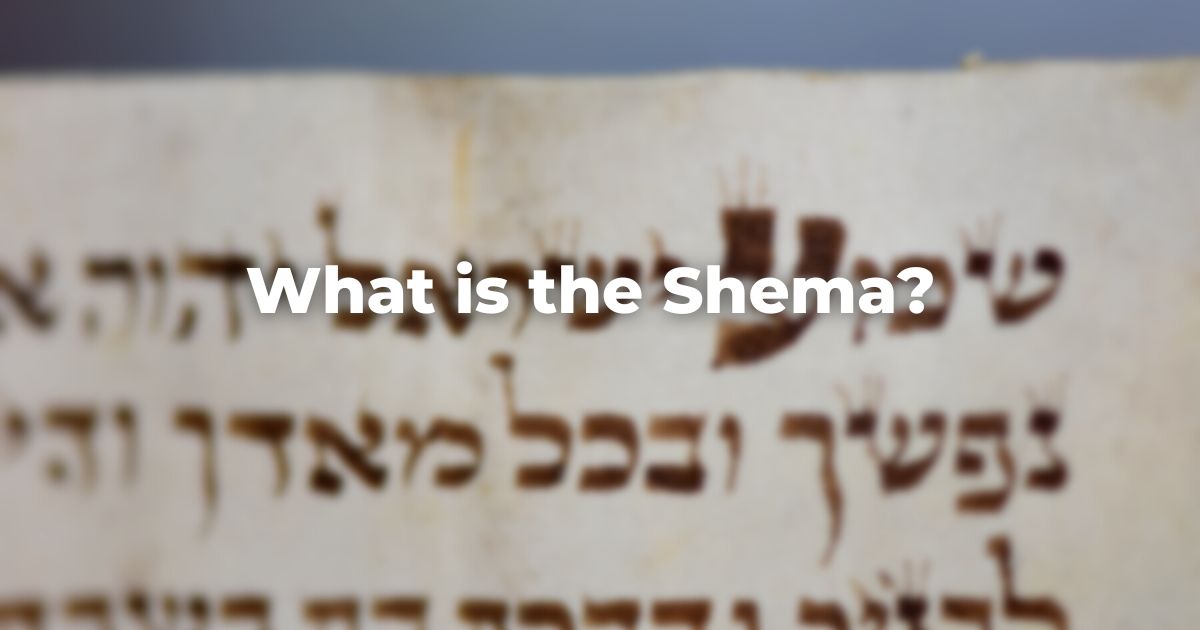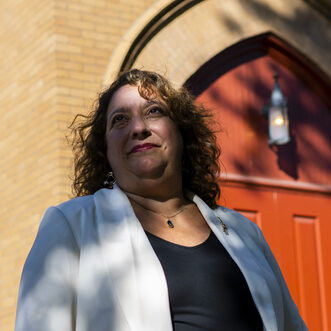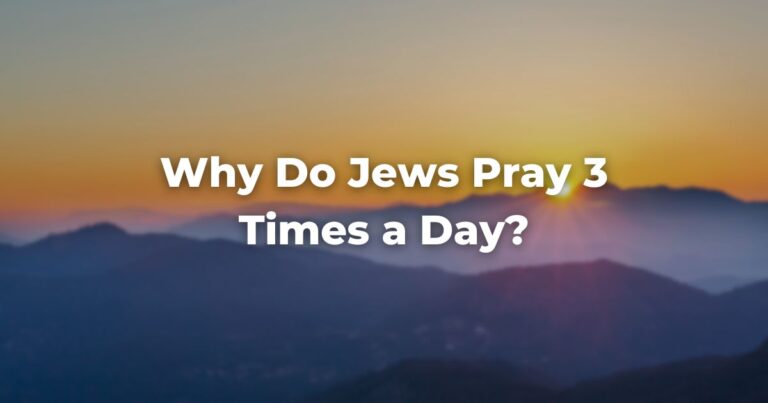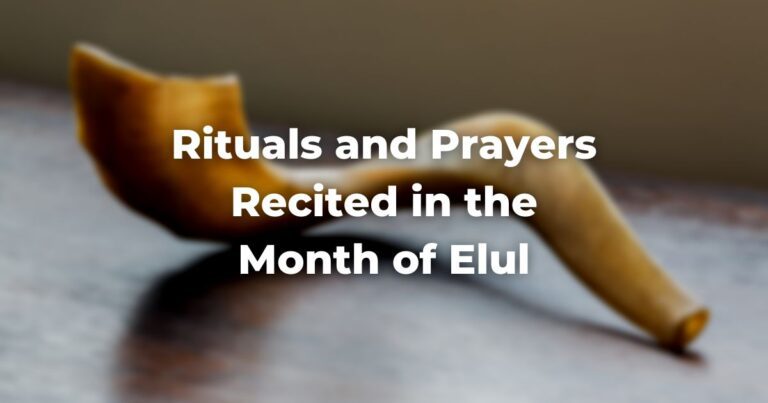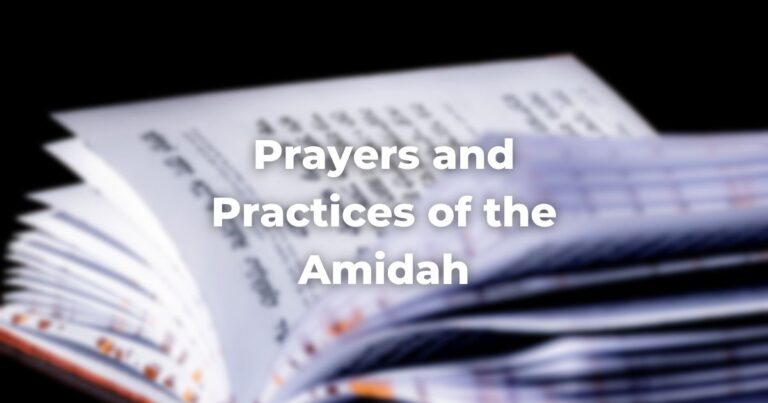Shema and the Surrounding Blessings
The Shema (also spelled sh’ma) is not, strictly speaking, a prayer; it is the declaration of God’s uniqueness and unity that the TorahRefers to the first five books of the Hebrew Bible, the Tanakh, also called the Five Books of Moses, Pentateuch or the Hebrew equivalent, Humash. This is also called the Written Torah. The term may also refer to teachings that expound on Jewish tradition. Read more commands us to recite twice daily.
Although Deuteronomy 6:4 is called the Shema in our sources (as in M Berakhot 1:1), the fuller rabbinic version comprises three distinct passages: Deuteronomy 6:4–9, Deuteronomy 11:13–21, and Numbers 15:37–41.
Together, these are called K’riat Shema (the recitation of the shema) and it is in that full liturgical setting that the Shema is read aloud as part of the synagogue service.
The recitation of the Shema is preceded and followed by benedictions: two before and one after in the morning, and two before and two after in the evening.
These contain key theological ideas intended to supplement the ideas presented in K’riat Shema.
The first of the preceding blessings focuses on creation, the second on revelation, and the blessing that follows focuses on redemption.
This central confession of faith is thus presented aloud in the synagogue surrounded by the core beliefs of the Jewish people about their origins, their destiny, and their God.
Tzitzit and Tefillin While Saying Shema
When reaching the word va-havi·einu in the blessing before the Shema, it is customary to gather the four tzitzit from the tallit in one’s left hand.
As we begin to recite the final paragraph of the Shema—which concerns the ritual donning of tzitzit—we switch the fringes to the right hand and kiss the tzitzit gathered together at the three mentions of the word.
We also kiss the tzitzit at the end of this paragraph, and then again when we say the words la·ad kayyamet in the paragraph following the Shema, at which point we let go of the gathered tzitzit.
Although this custom is not a universal one and there are halakhic authorities who object to it, it is very widespread and considered acceptable in almost all Conservative synagogues.
When the tefillin are mentioned at the end of the first paragraph of the Shema, it is customary to touch the boxes of the tefillin with the right hand. This is done again in the second paragraph as well.
We kiss the tzitzit and touch the tefillin as a tactile reminder of our obligations to remain faithful to the mitzvot in our daily lives, and as a sign of our love for the commandments.
Vocalizing the Shema
After reciting the primary verse of the Shema aloud, every individual recites the words barukh sheim k’vod malkhuto le’olam va·ed (Blessed is The Name, Whose glorious kingdom is forever) in a subdued voice or in an undertone.
There are different explanations of this practice.
In his work on the High Holy Day liturgy, Justice and Mercy (New York: Holt, Rinehart & Winston, 1963, pp. 72f.), Max Arzt suggested the simple explanation that the verse is recited in an undertone merely to underscore that it is a non-biblical passage interpolated into a section of biblical verses.
This personal affirmation of faith is an opportunity for the worshiper to personalize the proclamation of God’s unity by speaking in wholly human words not taken from Holy Writ.
When reciting one’s prayers without a minyan, the Shema is preceded by the three words eil melekh ne·eman (Almighty, faithful King). As part of a formally led prayer service, these three words are left out (see the gloss of the Rema to Shulchan Arukh, Orach Chayim 61:3).
The point is to keep the number of words in the greater Shema constant at 248—the number of positive commandments—by compensating for the words the prayer leader chants aloud during public worship with a minyan, and also for the “amen” omitted when the prayer leaders does not recite aloud the blessing before the Shema.
The added phrase’s initial letters, in fact, spell out the Hebrew word “amen.”
Thus, this passage provides an individual the opportunity to affirm her or his own belief in the unity of God by introducing the Shema with a special, subtle kind of amen.
Prohibited Interruptions
There should not be any interruptions in the service from the start of the Bar’khu through the end of the Amidah, except in the context of communal singing and the response of “amen” to a benediction.
Included in this category of forbidden interruption is any casual speech at all. Other than in an extreme circumstance, worshipers should feel obliged to focus wholly on their prayers during the recitation, private or public, of the service.
There is halakhic leeway to utter a word of greeting to someone of stature or particular respect between the paragraphs of the Shema, however (Shulchan Arukh, Orach Chayim 66:1).
Concluding Shema and Transitioning to the Amidah
At the end of the third paragraph of the Shema, the prayer leader includes the word emet from the next paragraph.
The Hebrew word emet means “truth” and so we affirm our sense that the unity of God is utterly true, not merely theologically, metaphorically, or symbolically so.
The paragraphs of the Shema illustrate God’s vast role in our lives.
By concluding the Shema with the word for “truth,” we publicly commit ourselves to doing the best we can to uncover the slivers of truth that glimmer through the obfuscating details of daily life.
Those that emerge from the focused, completely engaged effort to proclaim daily our belief in the unity and uniqueness of God.
In the mornings, the Shema is followed by a single benediction that ends with a formula praising God as the Redeemer of Israel.
It is universally agreed by the sources that one must proceed directly from this blessing to the recitation of the Amidah (BT Berakhot 4b, 9b, and 30a; Mishneh Torah, Prayer and the Priestly Blessing 7:17; Shulchan Arukh, Orach Chayim 66:8). This is a liturgical procedure called “adjoining [the blessing of] redemption to [the recitation of] prayer.”
To eliminate the requirement even to respond “amen,” there grew a very widespread custom for the prayer leader to recite the final words of the blessing, ga·al yisra·el, in an undertone. Thus, those present are freed from the normal obligation of responding to it and are able to go from their own recitation of the blessing directly into the Amidah.
In approving a 2003 responsum by Rabbi Robert Harris, the CJLS agreed that this custom may be regarded as optional and that if the prayer leader does recite the end of the blessing aloud, the congregation may respond “amen” in the normal way.
Adapted with permission from The Observant Life.
Authors
-

Rabbi Dr. Karen G Reiss Medwed, is Teaching Professor emerita at Northeastern University. She serves as Interim Vice Provost, Academic Affairs and Initiatives for HUC-JIR. Dr. Reiss Medwed's scholarship includes digital education, higher education leadership, and faith-based education. Dr. Reiss Medwed was ordained by JTS in 1995, and earned her Ph.D. from New York University's Steinhardt School of Education in Curriculum, Teaching and Learning with a specialization in Jewish education in 2005.
View all posts -

The Observant Life: The Wisdom of Conservative Judaism for Contemporary Jews distills a century of thoughtful inquiry into the most profound of all Jewish questions: how to suffuse life with timeless values, how to remain loyal to the covenant that binds the Jewish people and the God of Israel, and how to embrace the law while retaining an abiding sense of fidelity to one’s own moral path in life. Written in a multiplicity of voices inspired by a common vision, the authors of The Observant Life explain what it means in the ultimate sense to live a Jewish life, and to live it honestly, morally, and purposefully. The work is a comprehensive guide to life in the 21st Century. Chapters on Jewish rituals including prayer, holiday, life cycle events and Jewish ethics such as citizenship, slander, taxes, wills, the courts, the work place and so much more.
View all posts

